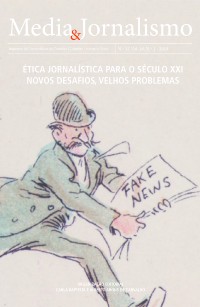Please use this identifier to cite or link to this item:
https://hdl.handle.net/10316.2/93483| Title: | Fake news nas redes sociais online: propagação e reações à desinformação em busca de cliques | Other Titles: | Fake news en las redes sociales online: propagación y reacciones a la desinformación en la búsquedada
por clics Fake news on online social media: propagation and reactions to misinformation in search of clicks |
Authors: | Delmazo, Caroline Valente, Jonas C. L. |
Keywords: | fake news;noticias falsas;redes sociales online;Facebook;libertad de expresión;fake news;false news;online social networks;Facebook;freedom of expression;fake news;notícias falsas;redes sociais online;Facebook;liberdade de expressão | Issue Date: | 2018 | Publisher: | Imprensa da Universidade de Coimbra | Abstract: | Noticias falsas, historias fabricadas, rumores, titulares que son cebos de clics (las llamadas clickbaits) no son novedad. La diferencia del actual contexto es el potencial de circulación de las llamadas fake news en el ambiente online, sobre todo en virtud del uso de las redes sociales. El presente artículo tiene el objetivo de destacar las características del mundo online que facilitan la diseminación de las noticias falsas, mostrar ejemplos recientes de fake news que ganaron grandes proporciones por la propagación en las redes sociales - con destaque para el período preelectoral en los Estados Unidos en 2016-, y presentar algunas de las reacciones principales a lo que llamamos “problema de las noticias falsas”, divididas según la naturaleza de sus autores en cuatro grupos: (1) Plataformas digitales; (2) Organizaciones de investigación y de la sociedad civil y los medios de comunicación; (3) Gobiernos y organismos estatales; (4) Organismos Internacionales. Notícias falsas, histórias fabricadas, boatos, manchetes que são isco de cliques (as chamadas clickbaits) não são novidade. A diferença do atual contexto é o potencial de circulação das chamadas fake news no ambiente online, sobretudo em virtude do uso das redes sociais digitais. O presente artigo tem o objetivo de destacar as características do mundo online que facilitam a disseminação das notícias falsas, elencar exemplos recentes de fake news que ganharam grandes proporções graças à propagação nas redes sociais, com destaque para o período pré-eleitoral nos Estados Unidos em 2016, e mapear algumas das principais reações ao que chamamos de “problema das notícias falsas”, divididas segundo a natureza institucional de seus autores em quatro grandes grupos: (1) Plataformas digitais; (2) Organizações de pesquisa e da sociedade civil e os media; (3) Governos e órgãos estatais; e (4) Organismos Internacionais. Fake news, created stories, hoaxes and headlines that are clickbaits. There is nothing new about it. The difference, at the present time, is the potential of fake news circulation in the online environment, mainly due to the use of online social networks. This article aims to highlight the characteristics of the online world that facilitate the dissemination of fake news, to list recent examples of fake news that have gained great proportions thanks to the spread in social networks - especially in the pre-election period in the United States in 2016-, and map some of the main reactions to what we call the “fake news problem”, organized according to the nature of its authors in four large groups: (1) Digital platforms; (2) Research organizations and civil society and the Media; (3) Governments and state bodies; and (4) International organizations. |
URI: | https://hdl.handle.net/10316.2/43903 | ISSN: | 1645‑5681 2183-5462 (digital) |
DOI: | 10.14195/2183-5462_32_11 | Rights: | open access |
| Appears in Collections: | Media & Jornalismo |
Files in This Item:
| File | Description | Size | Format | |
|---|---|---|---|---|
| fake_news_nas_redes_sociais_online.pdf | 1.77 MB | Adobe PDF |  |
Items in DSpace are protected by copyright, with all rights reserved, unless otherwise indicated.
